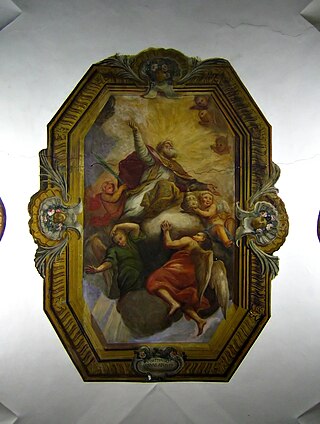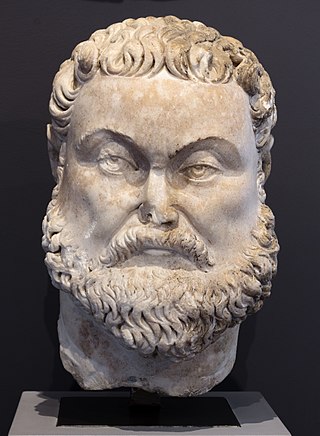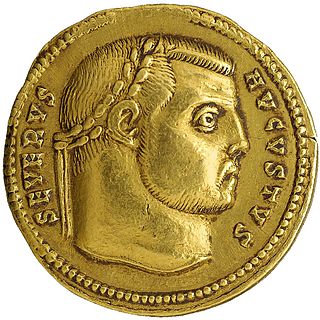
Pope Marcellus I was the bishop of Rome from May or June 308 to his death. He succeeded Marcellinus after a considerable interval. Under Maxentius, he was banished from Rome in 309, on account of the tumult caused by the severity of the penances he had imposed on Christians who had lapsed under the recent persecution. He died the same year, being succeeded by Eusebius. His relics are under the altar of San Marcello al Corso in Rome. Since 1969 his feast day, traditionally kept on 16 January by the Catholic Church, is left to local calendars and is no longer inscribed in the General Roman Calendar.

Year 308 (CCCVIII) was a leap year starting on Thursday of the Julian calendar. It was known in the Roman Empire as the Year of the Consulship of Diocletian and (Galerius) Maximianus. The denomination 308 for this year has been used since the early medieval period, when the Anno Domini calendar era became the prevalent method in Europe for naming years.

The Battle of the Milvian Bridge took place between the Roman Emperors Constantine I and Maxentius on 28 October 312 AD. It takes its name from the Milvian Bridge, an important route over the Tiber. Constantine won the battle and started on the path that led him to end the Tetrarchy and become the sole ruler of the Roman Empire. Maxentius drowned in the Tiber during the battle; his body was later taken from the river and decapitated, and his head was paraded through the streets of Rome on the day following the battle before being taken to Africa.

Maximian, nicknamed Herculius, was Roman emperor from 286 to 305. He was Caesar from 285 to 286, then Augustus from 286 to 305. He shared the latter title with his co-emperor and superior, Diocletian, whose political brain complemented Maximian's military brawn. Maximian established his residence at Trier but spent most of his time on campaign. In late 285, he suppressed rebels in Gaul known as the Bagaudae. From 285 to 288, he fought against Germanic tribes along the Rhine frontier. Together with Diocletian, he launched a scorched earth campaign deep into Alamannic territory in 288, refortifying the frontier.

Marcus Aurelius Valerius Maxentius was a Roman emperor, who reigned from 306 until his death in 312. Despite ruling in Italy and North Africa, and having the recognition of the Senate in Rome, he was not recognized as a legitimate emperor by his fellow emperors.

Flavius Valerius Severus, also called Severus II, was a Roman emperor from 306 to 307. After failing to besiege Rome, he fled to Ravenna. It is thought that he was killed there or executed near Rome.

The Circus of Maxentius is an ancient structure in Rome, Italy, part of a complex of buildings erected by emperor Maxentius on the Via Appia between AD 306 and 312. It is situated between the second and third miles of the Via Appia, between the basilica and catacombs of San Sebastiano and the imposing late republican tomb of Caecilia Metella, which dominates the hill that rises immediately to the east of the complex. It is part of the Appian Way Regional Park.

Stenopelmatidae is a family of large, mostly flightless orthopterans that includes the Jerusalem crickets. Two genera: Ammopelmatus and the type genus Stenopelmatus are found in the New World. Oryctopus and Sia are Old World genera, and previously placed in their own subfamilies, but with the addition of new genera, current placement is as five tribes in the single subfamily Stenopelmatinae.

The Basilica of Maxentius and Constantine, sometimes known as the Basilica Nova—meaning "new basilica"—or Basilica of Maxentius, is an ancient building in the Roman Forum, Rome, Italy. It was the largest building in the Forum, and the last Roman basilica built in the city.

Amnicola is a genus of very small freshwater snails which have an operculum. Amnicola species are aquatic prosobranch gastropod mollusks in the family Amnicolidae according to the taxonomy of the Gastropoda.

Saurita is a genus of moths in the subfamily Arctiinae. The genus was erected by Gottlieb August Wilhelm Herrich-Schäffer in 1855.

Gryllus is a genus of field cricket. Members of the genus are typically 15–31 mm long and darkly coloured. The type species is Gryllus campestris L.: the European field cricket.

Phostria is a genus of moths of the family Crambidae.

The Phaneropterinae, the sickle-bearing bush crickets or leaf katydids, are a subfamily of insects within the family Tettigoniidae. Nearly 2,060 species in 85 genera throughout the world are known. They are also known as false katydids or round-headed katydids.

The civil wars of the Tetrarchy were a series of conflicts between the co-emperors of the Roman Empire, starting from 306 AD with the usurpation of Maxentius and the defeat of Severus to the defeat of Licinius at the hands of Constantine I in 324 AD.

Sparganothis is a genus of moths belonging to the subfamily Tortricinae of the family Tortricidae.
Carsidaridae is a bug family in the superfamily Psylloidea, with a world-wide distribution; the type genus Carsidara is from eastern Asia.

The Mausoleum of Maxentius was part of a large complex on the Appian Way in Rome that included a palace and a chariot racing circus, constructed by the Emperor Maxentius. The large circular tomb was built by Maxentius in the early 4th century, probably with himself in mind and as a family tomb, but when his young son Valerius Romulus died he was buried there. After extensive renovation the mausoleum was reopened to the public in 2014.

Ruspolia is a genus of bush crickets in the subfamily Conocephalinae. This genus includes species that may be called 'cone-heads', but the name has also been used for Conocephalus and other genera in the subfamily.


















